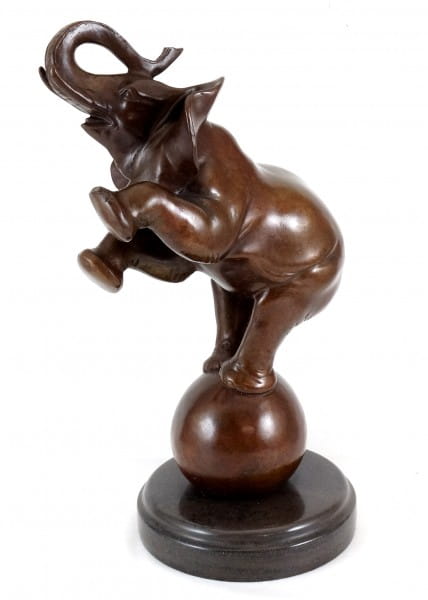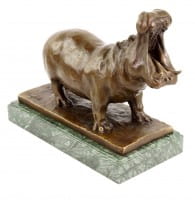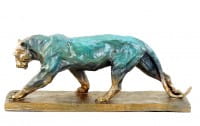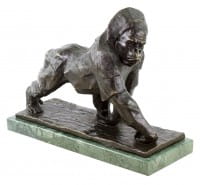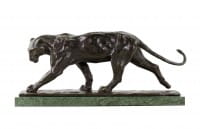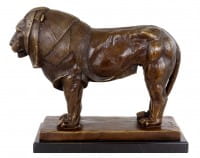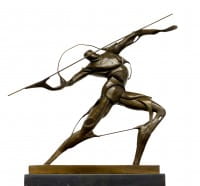€399.00 *
Prices incl. VAT, free shipping worldwide
Ready to ship today,
Delivery time appr. 3-6 workdays










Bronze Animal Sculpture - Elephant on Ball - Signed Bugatti Rembrandt Bugatti was born... more
Product description
"Elephant Statue - Elephant on Ball - Rembrandt Bugatti "
| Weight | 3,9 kg |
Bronze Animal Sculpture - Elephant on Ball - Signed Bugatti
Rembrandt Bugatti was born on October 16, 1884, in Milan, Italy, into a family steeped in artistic tradition and mechanical innovation. The son of famed designer Carlo Bugatti and brother of automobile pioneer Ettore Bugatti, Rembrandt charted a more intuitive and expressive path. From a young age, he demonstrated a profound sensitivity toward animals, observing their habits, personalities, and emotions with unwavering attention. This deep connection became the emotional and formal foundation of all Rembrandt Bugatti sculptures, which are celebrated for their psychological realism and tactile vitality. By the time he was in his twenties, Bugatti was already recognized as one of the most gifted animal sculptors of his generation.
A Rare Moment of Joy and Movement
While many Rembrandt Bugatti sculptures capture animals in moments of solitude, quiet intensity, or instinctive behavior, Elephant on Ball stands apart as a spirited interpretation of play and poise. This elephant statue presents a youthful, exuberant elephant balanced atop a large sphere, its trunk lifted in exuberance and its limbs gathered mid-motion. The posture suggests controlled imbalance, a theatrical moment frozen in bronze. Though the subject evokes the world of the circus, it is not a caricature. This is no sentimental sculpture elephant, but a study in animal energy, physicality, and coordination—rendered with Bugatti’s trademark sensitivity to form and volume.
A Celebration of Sculptural Balance
The technical complexity of Elephant on Ball lies in its contrast between mass and levity. The elephant’s body is broad and weighty, yet the entire form balances delicately on the smooth curve of the sphere. This juxtaposition enhances the sculpture’s visual tension and narrative charm. Unlike academic elephant sculpture that emphasize exoticism or grandeur, Bugatti’s elephant is approachable, intimate, almost playful. The composition draws the viewer in, encouraging a slow gaze around the rotating form, rewarding attention with shifting planes and expressive curves. It is a sculpture of movement held in stasis, a visual echo of rhythm and performance.
Bronze as Living Surface
As in all Rembrandt Bugatti sculptures, the surface of the bronze is alive with texture. The skin of the elephant, while subtly modeled, avoids overworked detail, allowing the form to breathe. The polish is warm and inviting, giving the elephant statue a sense of tactile vitality. The base, rounded and grounded, anchors the work while reinforcing the theme of balance and elegance. Bugatti’s choice of patina enhances the interplay between light and shadow, creating a sculpture that changes mood with every shift of illumination. It is a work that invites touch as much as sight.
Paris and the World of Performance
Elephant on Ball was likely conceived in Paris, where Bugatti spent a significant portion of his brief but prolific career. During this time, he had access to animals in menageries and traveling circuses, observing them not only as biological specimens but as emotional beings. In this sculpture elephant, one senses not just the anatomy of the creature, but its personality—its curiosity, perhaps its joy in movement or interaction. Unlike many depictions of circus animals which lean into spectacle or kitsch, Bugatti’s version is refined, intelligent, and deeply respectful.
A Signature of Authentic Presence
The base of this bronze proudly bears the name Rembrandt Bugatti, a signature that confirms not only authorship but integrity. Every one of his sculptures—especially rare works like this elephant sculpture—was the result of direct observation, rapid modeling in plastiline, and meticulous casting in limited editions. Nothing was generalized. Bugatti sculpted with empathy and immediacy, capturing what he saw, felt, and intuited. This makes every Rembrandt Bugatti sculpture a document of shared life, a meeting point between species, frozen in bronze.
A Life Interrupted, A Legacy Eternal
Rembrandt Bugatti’s life was tragically short. He took his own life in 1916, devastated by the trauma of war and the death of many of the animals he had once sculpted and loved. Yet his work endures, growing only more revered with time. Today, Rembrandt Bugatti sculptures are housed in the most prestigious museums and private collections across the globe. Elephant on Ball, with its joyful strength and compositional elegance, remains one of the most unexpected and engaging pieces in his oeuvre. It is both celebration and sculpture, both monument and motion—a testament to the enduring magic of animal form seen through the eyes of a poetic master.
Rembrandt Bugatti was born on October 16, 1884, in Milan, Italy, into a family steeped in artistic tradition and mechanical innovation. The son of famed designer Carlo Bugatti and brother of automobile pioneer Ettore Bugatti, Rembrandt charted a more intuitive and expressive path. From a young age, he demonstrated a profound sensitivity toward animals, observing their habits, personalities, and emotions with unwavering attention. This deep connection became the emotional and formal foundation of all Rembrandt Bugatti sculptures, which are celebrated for their psychological realism and tactile vitality. By the time he was in his twenties, Bugatti was already recognized as one of the most gifted animal sculptors of his generation.
A Rare Moment of Joy and Movement
While many Rembrandt Bugatti sculptures capture animals in moments of solitude, quiet intensity, or instinctive behavior, Elephant on Ball stands apart as a spirited interpretation of play and poise. This elephant statue presents a youthful, exuberant elephant balanced atop a large sphere, its trunk lifted in exuberance and its limbs gathered mid-motion. The posture suggests controlled imbalance, a theatrical moment frozen in bronze. Though the subject evokes the world of the circus, it is not a caricature. This is no sentimental sculpture elephant, but a study in animal energy, physicality, and coordination—rendered with Bugatti’s trademark sensitivity to form and volume.
A Celebration of Sculptural Balance
The technical complexity of Elephant on Ball lies in its contrast between mass and levity. The elephant’s body is broad and weighty, yet the entire form balances delicately on the smooth curve of the sphere. This juxtaposition enhances the sculpture’s visual tension and narrative charm. Unlike academic elephant sculpture that emphasize exoticism or grandeur, Bugatti’s elephant is approachable, intimate, almost playful. The composition draws the viewer in, encouraging a slow gaze around the rotating form, rewarding attention with shifting planes and expressive curves. It is a sculpture of movement held in stasis, a visual echo of rhythm and performance.
Bronze as Living Surface
As in all Rembrandt Bugatti sculptures, the surface of the bronze is alive with texture. The skin of the elephant, while subtly modeled, avoids overworked detail, allowing the form to breathe. The polish is warm and inviting, giving the elephant statue a sense of tactile vitality. The base, rounded and grounded, anchors the work while reinforcing the theme of balance and elegance. Bugatti’s choice of patina enhances the interplay between light and shadow, creating a sculpture that changes mood with every shift of illumination. It is a work that invites touch as much as sight.
Paris and the World of Performance
Elephant on Ball was likely conceived in Paris, where Bugatti spent a significant portion of his brief but prolific career. During this time, he had access to animals in menageries and traveling circuses, observing them not only as biological specimens but as emotional beings. In this sculpture elephant, one senses not just the anatomy of the creature, but its personality—its curiosity, perhaps its joy in movement or interaction. Unlike many depictions of circus animals which lean into spectacle or kitsch, Bugatti’s version is refined, intelligent, and deeply respectful.
A Signature of Authentic Presence
The base of this bronze proudly bears the name Rembrandt Bugatti, a signature that confirms not only authorship but integrity. Every one of his sculptures—especially rare works like this elephant sculpture—was the result of direct observation, rapid modeling in plastiline, and meticulous casting in limited editions. Nothing was generalized. Bugatti sculpted with empathy and immediacy, capturing what he saw, felt, and intuited. This makes every Rembrandt Bugatti sculpture a document of shared life, a meeting point between species, frozen in bronze.
A Life Interrupted, A Legacy Eternal
Rembrandt Bugatti’s life was tragically short. He took his own life in 1916, devastated by the trauma of war and the death of many of the animals he had once sculpted and loved. Yet his work endures, growing only more revered with time. Today, Rembrandt Bugatti sculptures are housed in the most prestigious museums and private collections across the globe. Elephant on Ball, with its joyful strength and compositional elegance, remains one of the most unexpected and engaging pieces in his oeuvre. It is both celebration and sculpture, both monument and motion—a testament to the enduring magic of animal form seen through the eyes of a poetic master.
Height: 34 cm
Width: 20 cm
Depth: 14 cm
Weight: 3,9 kg
100% bronze
Related links to "Elephant Statue - Elephant on Ball - Rembrandt Bugatti"
Read, write and discuss reviews... more
Customer evaluation for "Elephant Statue - Elephant on Ball - Rembrandt Bugatti"
Write an evaluation
Evaluations will be activated after verification.
Our advantages
free shipping
Worldwide free shipping
14 days money back
You can cancel your order
within 14 days
secure payment services
Paypal, Master Card, Visa, American Express and more
NEW
NEW











